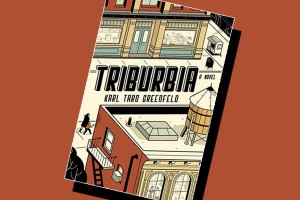I Like __ A Lot
Fan Mail #5: Karl Taro Greenfeld
Thank you for sending me your book, even though you said—cheekily—that I would hate it. I didn’t. Your artificial humility was unearned. Triburbia is a fabulous book, not fabulous as in fabulist, no it’s realist, as real as a utopia about Tribeca can be. I use the word utopia with real care. Triburbia is not the kind of utopia Thomas More would think up, but for your characters, Tribeca is utopia. To have a place in Tribeca is to have achieved, to have made it, and yet, and yet, here they are, suffering just like the rest of us plebs.
Karl Taro Greenfeld, reviewers have been quick to do two things: compare Triburbia to Joyce’s Dubliners and pound on you about how dislikeable your characters are. Whereas I can see the comparison to Dubliners—that is, geography is story, geography becomes narrative—I don’t think that’s the most apt comparison. You two aim at very different things, with very different points of both departure and arrival. If anything, I think Triburbia is a lot like Georges Perec’s Life, A User’s Manual—this is no small compliment—only more modest in scope. The irony being your book is geographically situated in an entire neighborhood, whereas Perec’s is a mere apartment building. Much like both you and Joyce, Perec’s building becomes its own character. It’s what Dublin is to Joyce, the building is to Perec, and Tribeca is to you. Maybe it’s something to do with the difference between space and place. (I was in this PhD program a few years back in Geography. I finished my course work and I still don’t know the fucking difference between place and space, and don’t even get me started on scale!) In most fiction, setting is just place, a physical locale for the action to occur, but for you, Tribeca is a space. It’s not mystical or anything, but we’re talking more like space as empty container, and that’s what Triburbia is. That’s more Perec’s style than Joyce. Furthermore, Perec’s Life has a similar structure—albeit more playful and perhaps sophisticated—to your book. The chapters in his book move along a knight’s tour. Yours seems more arbitrary, but the idea is the same: chapters titled by physical location, chapters accumulating to create a space more than the place itself could.
As to the charge that your characters are unlikeable, well, it’s no requirement that the reader should like the character. Furthermore, I think your characters are immensely likeable. Sure, ok, so they’re privileged artist assholes who have charmed lives, so what? I loved reading this book like I love watching Girls. It’s a vicarious pleasure.
Only here’s the thing, all privilege and assholery aside, I enjoyed your characters because they were relatable. I’m no New York hipster, mind you—fuck: I am provincial, people. I’m so goddamn provincial I had to Google Tribeca. I didn’t even know it was in Manhattan. I didn’t know anything about it. Still don’t, other than what you and Jay-Z have taught me. That is, you both live in Tribeca, which must mean something. Do you see Jay-Z around? Do you hang with Beyonce?—but I still found them empathetic and emphatic in their suffering, which was mired in their privilege, sure, but I guess maybe that’s the thing. People love to watch rich people suffer. And I could watch rich artists suffer all day just to make myself feel better. Maybe I’m fucked up like that.
So here’s what I liked about your book, Karl Taro Greenfeld: the writing. Your sentences are polyphonic but without the chatter. You’re not a clean writer, but that’s part of what I appreciate about you. There’s a messiness that I adore, a playfulness that I associate with urgency. Ok, sure, sometimes you get a little indulgent and other times you fall into a cliché or two, but that happens. For the most part, KTG, I loved the voice and personality your sentences draw, like:
There was nothing wrong with Sadie’s looks, but one would be hard-pressed to remark on them. Black hair, brown eyes, a thick arc of black eyebrow, good nose, freckles, thin lips. Pretty enough, analyzed feature by feature, but then step back and Sadie was just a few crucial inches too short to pass for normal. And she wasn’t thin. The effect of her, then, was like being in the presences of a beautiful block. But what is wonderful about a perfect square? (175)
Or this gem, first published in Harper’s:
You should see who my friends married in the nineties. It wasn’t like now, where girls are marrying, like, handsome, mixed-race guys with good hair who ride bicycles. Do you know what men were like in New York in the nineties? White and boring. They had real jobs—lawyers, architects, doctors. And they were DULL. I had girlfriends I used to get stoned with every night and do blow with at Limelight and who would even suck off some guy with dreadlocks at Robots, but who ended up marrying, like, an IT guy from Boston. Pretty girls who would go from dating an English junkie to a Long Island accountant. Those seemed like the only choices back then. Now, you have these hybrids. I don’t know what guys do anymore, but it seems like when I meet a man in his twenties or thirties, he does something in advertising or marketing, but is more defined by his hobby of riding fixed-gear-bicycles or some intense and very particular food enthusiasm. (34)
Karl Taro Greenfeld, Triburbia is some money latticework, my friend. All of the characters interact, they all fuck each other, or, think about fucking each other. There’s the token queer man, but his queerness is incidental, barely noticeable. Similarly, everyone is white, maybe that’s the way in Tribeca, except for the token you. I don’t really care, just like I don’t care that all the girls on Girls are white. Call it my desire to be unOthered. But I’m getting distracted. I was complimenting you. I love the occasion for this novel: fathers dropping off their kids, having coffee, bitching. And, of course, you’ve got that juicy sex scandal in there. But back to the dads, I love their self-indulgence and ego, the way they have such little care for things external to themselves. In many ways, I enjoyed your novel because your characters, flawed though they may be, are exactly what I wish I could be. But I’m not. Maybe because I don’t live in Tribeca!
Reading your book, I was reminded also of Gilbert Sorrentino’s Imaginative Qualities of Actual Things. Again, this is no small compliment. Sorrentino’s novel—also more of a linked collection than a novel like yours, but whatever, genre is so passé— takes place in New York and all the characters are New York artist-intellectual-bohemian-assholes. Sorrentino’s book takes place in the 50s and 60s, and your book feels like an extension of it, only without so much meta- stuff, but that’s Sorrentino’s cup. I worked for Sorrentino, mapped out characters and romances and entanglements and I was willing to do the same for your book. I think it’s a testament to something when a reader works—is compelled to work—to understand a book. Yet I didn’t have to work to enjoy this book. I could’ve read it on the beach—or pile of dirt, since I live in the desert—pecked at it like an anorexic, and still, I would’ve felt satisfaction after finishing it. Your novel has the exotic quality of being both accessible and intricate. The reader gets what she wants from it.
Your opening chapter made me compulsive. Between the stylish voice that is at once subdued and all flair and the hook of the sex scandal, compounded with the racial bombardments, I felt stolen into your novel, like you’d kidnapped me and forced me to stay there, in the page, I read your book in one sitting. There’s something in your characters’ pathetic mourning and their ridiculous success that makes them simply – wonderful.
I loved Mark, your half-Asian, half-white sound tech (an obvious version of you), I loved Rick, the lying essayist and memoirist (also you. It’s funny to me that all the reviews cite James Frey, when you are your own model, if that’s true: what’s true!?!), and then there’s Sadie, the not pretty girl who fucks Mark in order to blackmail him to pay for her college education. Each and every one of your characters is a total gem. They are audacious because they don’t know any other way to be. Your book gets at the fundamental insecurity that is the core of all narcissism, the insecurity that is the core of most sexual encounters of any kind, the insecurity that is the core of cruelty. I loved these characters because they’re not just sad. They’re fucked. They are the elite. They are what so many people aspire towards: a loft in Tribeca, a hot spouse, money enough to have steak for breakfast. And you expose Tribeca to a country girl like me, gifting me all its romance and its grit. I am enticed in its dramatics, some of which are just so banal, just like me, your novel gifts me disgust and desire, a goal, maybe, a deterrent. Thank you, KTG, for this book, it’s precious, in the best and worst ways, and as such, it’s a success.
XOXO, Lily
Tags: Fan Mail, karl taro greenfeld



[…] building. Much like both you and Joyce, Perec’s building becomes its own character. – From HTMLGiant Share this:FacebookTwitterLike this:LikeBe the first to like […]
Karl is awesome.